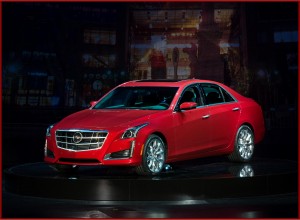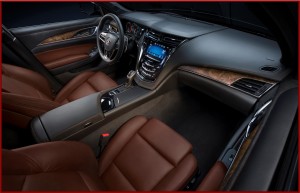In GM’s latest attempt to make Cadillac a global brand, it is increasing the size of the CTS while toning down its distinctive styling that made it successful in the U.S. but is thought too radical for offshore customers of German and Japanese luxury cars. This no doubt will set off an interminable and pointless debate about whether Cadillac can catch BMW; the answer of which is not any time soon as it is a decades long task.
The third-generation CTS sedan is based on the rear-drive architecture of the competent compact ATS sport sedan, but in a larger mid-size package that starts production this fall in Lansing, Michigan. A range engines and transmission will be available, including the all-new Cadillac Twin-Turbo engine and GM’s first eight-speed automatic transmission in top of the line Vsport (sic) models.
Cadillac claims that the longer and lower proportions are more “athletic” and is an “evolution” of the angular look introduced as part of the brand’s Art & Science design philosophy that the original CTS debuted. In reality, the sharp angular stance has been rounded off, moving the styling more – but not all the way – toward mainstream inoffensive, ironically at the same time as BMW is adding angles and creases. While growing five inches in length, including a 1.2-inch longer wheelbase, the CTS roofline and cowl at the base of the windshield are about an inch lower, resulting in a slight loss of EPA rated interior and trunk space down to 110.6 cubic feet from the existing 111.6.
The CTS sedan has a lower curb weight than the preceding model and weighs about 200 pounds (90 kg) less than the BMW 528i. Lightweight techniques include Cadillac’s first aluminum door structures, which contribute to the lower weight and a nearly 50/50 weight balance. Moreover, for the first time on CTS, Magnetic Ride Control, Cadillac’s real-time damping system, is available on base models.
The most powerful combination is a turbocharged V6 engine rated at 420 horsepower (313 kW) and 430 lb.-ft. of torque (583 Nm), making it for the moment the most power-dense six-cylinder engine in the segment. A pair of smaller turbochargers helps provide better response, with approximately 90% of peak torque available from 2,500 rpm to 5,500 rpm. Zero-to-60 mph elapsed times are estimated at 4.6 seconds. No doubt it can run against BMW on the track, and is needed in an image race where Cadillac is laps behind. (Read AutoInformed on Cadillac Twin-Turbo Debuts in All-New 2014 CTS Sedan)
The CTS Vsport also has:
- 18-inch aluminum wheels with Pirelli summer-only performance tires – just like the Germans spec, although 19-inch wheels with all-season tires are available
- A quicker steering ratio
- Brembo disc brakes with aluminum calipers and higher-performance brake pads,
- Heavy-duty track cooling package
- Driver-selectable track mode with specific steering rate and Magnetic Ride Control calibrations for greater track performance
- Electronic limited-slip differential that enhances capability on the track – including optimal acceleration out of turns
When the 2014 CTS sedan goes on sale, it will also offer a naturally-aspirated 3.6-liter V6 rated at 321 horsepower, as well as a 2-liter, four-cylinder, turbocharged engine rated at an estimated 272 horsepower. The Twin Turbo V6 engine will also will be offered in the 2014 XTS large luxury sedan this fall. (Read AutoInformed on Cadillac XTS Sedan Unveiled With a V6 and All Wheel Drive)
CTS technologies also include:
- Cadillac’s first 20-way adjustable front seats
- Motorized cup holder lid in the center console
- Heated and cooled (ventilated) front seats and heated steering wheel
- Electronically locking glove box
- Electronic parking brake
- Adaptive remote start feature that also activates the climate control system
- Standard Bose eleven-speaker sound system and an optional Bose system with 13 speakers
The new CTS sedan is the first Cadillac to offer an optional Automatic Parking Assist, which enables the car to park itself in parallel spaces. It uses ultrasonic sensors to locate a suitable space and maneuver the car into the space, with the driver only required to engage reverse and apply the accelerator and brake pedals. Ultrasonic rear park assist is standard.
The ultrasonic sensors, as well as radar and cameras, also help to prevent crashes. Among the most sophisticated is Front and Rear Automatic Braking, which relies on short-range radar technology and ultrasonic sensors to help the driver prevent front and rear low-speed collisions via a progression of alerts that extend to complete braking, if the distracted driver does not stop texting or playing with the CUE infotainment system.
A Driver Awareness Package includes Cadillac’s Safety Alert Seat technology. It uses vibrating pulses in the driver’s seat to alert the driver to an imminent collision or to vehicles in the car’s blind spot. The seat vibrates on the left or right side, or both sides simultaneously, depending on the direction of the risk.
GM’s first application of automatic safety belt tightening is also offered in the new CTS. It automatically takes slack out of the safety belts when buckled and offers real-time, active adjustments during driving to ensure optimal tension and comfort. Additional optional safety features include:
- Full Speed Range Adaptive Cruise Control
- Panic Brake Assist
- Forward Collision Alert
- Automatic Collision Preparation (with brake prefill)
- Lane Departure Warning
- Side Blind Zone Alert
- Rear Cross Traffic Alert
- Rear Vision Camera With Dynamic Guidelines
- Adaptive Forward Lighting
- Active pedestrian protection system (in global regions where required).
The new CTS sedan also has 10 standard air bags, including front-passenger dual-stage deployment, which makes the most of the air bag trajectory and inflation rate based on the occupant’s size, position and severity of the crash.



